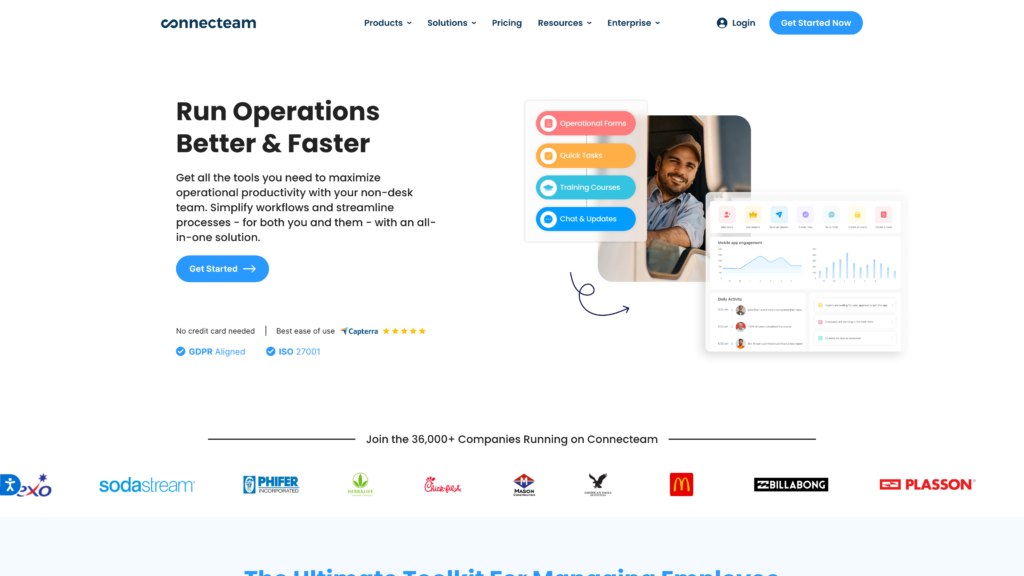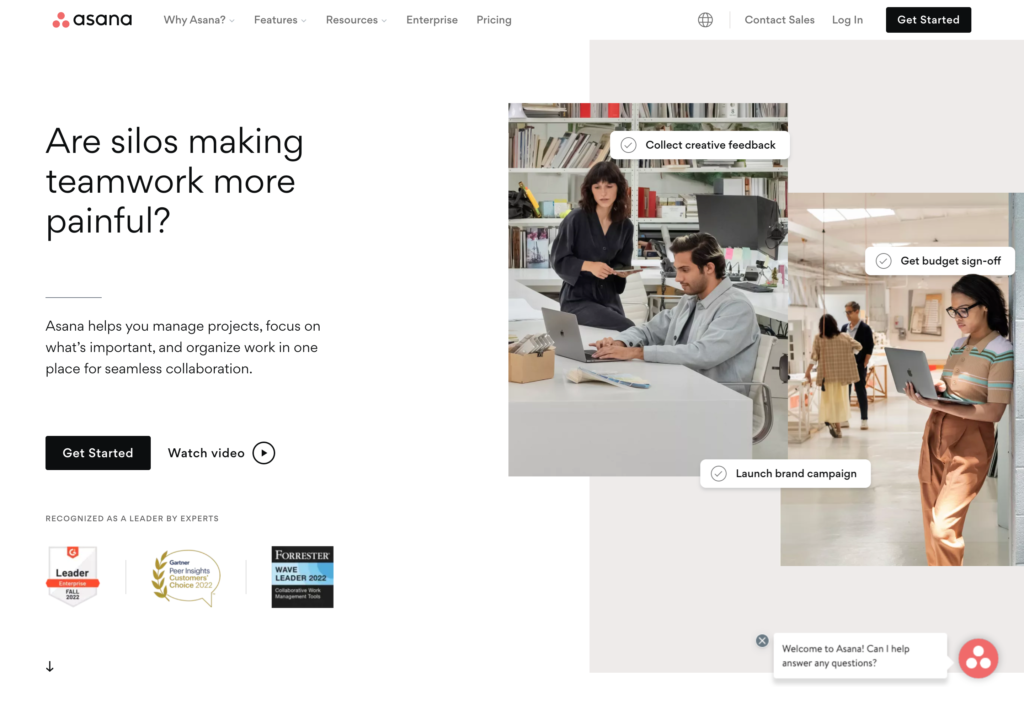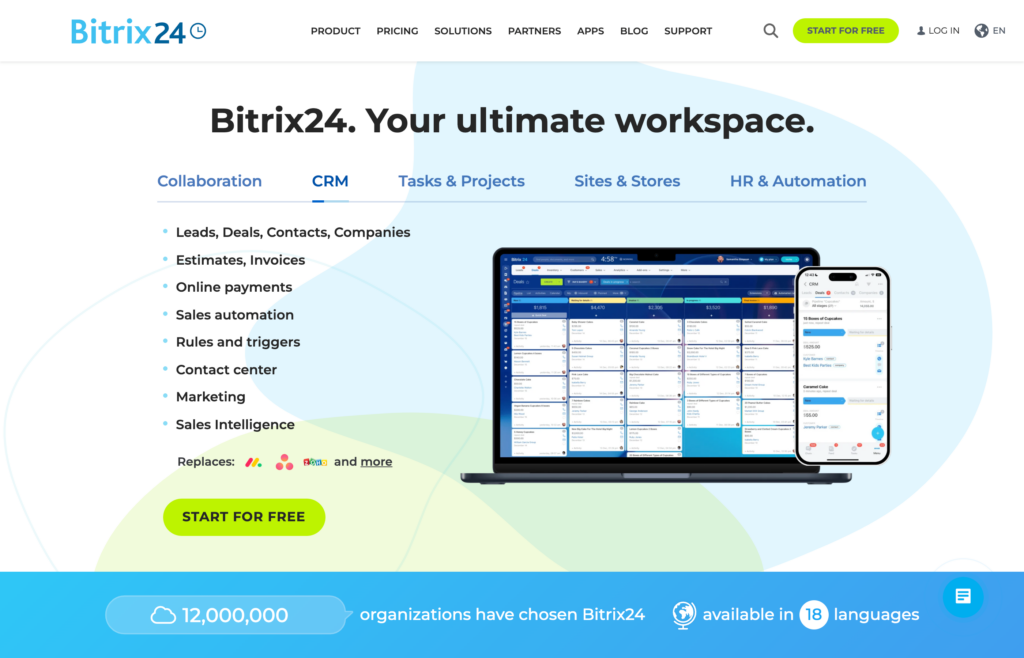Take control of your business with operations management software. Track projects and employees, manage schedules, reduce labor costs, communicate with your team, and more.
It’s useful for businesses of all sizes and industries, but especially for deskless workforces, like those in manufacturing, retail, hospitality, and logistics. These industries face unique challenges related to communications, training, safety and compliance, task management, and more.
The top operations management software solutions offer an all-in-one solution for tracking projects, managing schedules, and communicating with team members. This approach is simpler, cheaper, and more effective than using separate apps for all the different parts of your business. In fact, doing so can result in high overhead and labor costs, as well as losses in productivity and revenue.
In this article, we look at the top 5 operations management software for businesses in 2025, and explain how you can choose the best app for operations management.
Our Top Picks
-
Best all-in-one operations management solution
-
Good for task and project visualization
-

Good for job inspections and lone workers
Why trust us?
Our team of unbiased software reviewers follows strict editorial guidelines, and our methodology is clear and open to everyone.
See our complete methodology
17
Tools considered
10
Tools reviewed
5
Best tools chosen
What to Look For in a Operations Management Software
To get the most out of your operations management software, look for these features:
- Employee management. Few things impact your business as much as the motivation, skill, and organization of your employees. Prioritize apps with tools for scheduling and time tracking, training and onboarding, and motivating employees. The Connecteam app includes all of these, making it an employee management powerhouse.
- Project and task management. Like a well-oiled machine, every piece of a company must move together. At the start of every shift, employees should know what duties they have and how to complete them. Connecteam, for example, lets you create recurring checklists and assign them to shifts or teams.
- Secure messaging and chat. Effective communications help ensure projects are completed on time and within budget. Look for software that offers simple ways for workers to discuss projects and get answers to questions. For example, Connecteam’s chats can be grouped according to shift, project, client, task, or team. Everything’s stored securely in the cloud, too—never on a worker’s device.
- Logistics, supply chain, and inventory. Your business may need to monitor shipping, receiving, inventory, and production. This can be achieved in several ways. Some operations management software solutions have specific tools for doing so. Others, like Connecteam, allow you to create custom forms, task lists, and job reports that accomplish the same thing—and much more.
The 5 Best Operations Management Softwares of 2025
-
Connecteam — Best for: Best all-in-one operations management solution

Connecteam is the best operations management software and offers a wide range of tools for managing your entire business. Teams with non-desk workers in particular will find it useful for managing field workers and multiple locations.
Let’s take a closer look at what Connecteam can offer.
Feature-rich task management—built right into employee schedules
The key to good operations management is for everybody to know what they need to do, when they need to do it. Connecteam allows you to create checklists on the fly, or duplicate them from past projects or shifts and share them with your team. Not only does this help keep workers on task, but it also makes it easy for you to check employees’ progress from anywhere with the mobile app.
Detailed descriptions help give tasks more context, while due dates and subtasks help you break down complex projects into manageable steps.
Tasks and checklists can even be added to shifts when creating a schedule, too. Employees will see these and any other notes you’ve added.
Digital reports and forms save time and money
Most field work involves multiple forms for safety, compliance, customer service and satisfaction, and more. Connecteam allows you to digitize all your workflows, so you can send and receive reports, forms, and requests from your employees, no matter where they are.
With Connecteam’s digital forms, you can collect digital signatures. This allows workers and managers to easily sign off on important documents, like job site and safety inspections and start- or end-of-shift reports. Reminders ensure important forms are never missed.
Keep teams aligned with chat and updates
Great productivity and effective communications go hand in hand. Connecteam offers a number of ways to keep your employees aligned and in the loop. You can create secure group chats or one-on-one conversations with just a click, and share messages, audio and video recordings, documents and attachments, and more.
Managers have full control over which employees can message each other. You can manage permissions on an individual basis, for whole teams, or by using Connecteam’s Smart Groups feature. This allows you to define rules like, “All employees hired within the last 3 months,” and then create chats and apply permissions for those employees.
Updates provide a simple way to send out messages to groups or the whole company, and employees can respond with comments, support, and questions.
Everything is stored securely in the cloud, and never on employee devices. Conversations can’t be saved or exported outside the app, and when employees leave the company, they automatically lose access.
Streamline scheduling and track attendance and job progress
Connecteam includes a robust time-clock feature that’s simple to use and accurate down to the second. Connect shifts to specific tasks, projects, or clients, so you always know who’s working on what. Time-tracking is also GPS-enabled, so managers can ensure workers are at the right location in real time. Of course, when employees are clocked out, their location information remains completely private.
Creating schedules with Connecteam is easy, thanks to the built-in drag and drop scheduling app, templates, and recurring shifts. Not only does this streamline payroll, but it also makes it easier to guarantee shift coverage and comply with federal and local laws. With your approval, employees can even swap shifts when necessary, and automated shift reminders help prevent no-shows.
Maintain a skilled and knowledgeable workforce
Proper training is essential for an operationally sound and productive workforce. Connecteam enables you to create employee training courses with ease, using existing documents, PDF files, videos, and even your company website. Test learning and retention with skills, track progress and employee success, and more.
Connecteam’s knowledge base is an equally useful tool. It allows you to create a structured library of articles, policies, guidelines, instructions, and other documents for your team. It’s fully searchable, and can be accessed from anywhere using the Connecteam mobile app. All your information stays securely saved in the cloud and cannot be exported or saved without your permission.
And much more!
Connecteam is an all-in-one team management solution. In addition to all the tools necessary for operational excellence, you’ll also enjoy outstanding customer service, tools for HR and payroll, support for surveys and company events, and much more.
Connecteam also offers a free for life plan – Try Connecteam here!
Key Features
Quick tasks and checklists with due dates and subtasks
Digital forms and reports
Fully customizable training courses
Scheduling and time-tracking, with projects and tasks
Pros
All-in-one solution for operations, communications, and HR
Fully mobile: do anything from anywhere
Manage multiple projects, clients, and job sites
Communicate with and train employees effectively
Cons
No video conferencing yet
Pricing
Free-for-life plan availablePremium plans start at $29/month for 30 users
14-day free trial, no credit card required
Start your free trial -
Asana — Good For: Task and project visualization

Asana is a project management app that facilitates collaboration by allowing all team members to view tasks and projects. Employees and managers can assign tasks, leave comments, and access resources.
The software provides various ways to view work, such as through lists, kanban boards, Gantt charts, and calendars. This makes it easy for managers to keep track of multiple projects and balance employee workloads.
Asana also features automated workflows and task reminders, as well as integrations with popular business apps. The free version is available for teams of up to 15 people, although automation tools come at an extra cost. Additionally, there’s no built-in time tracking.
Key Features
- View tasks in Gantt charts, kanban boards, and more
- Rich-text descriptions and comments
- Custom workflow automations
- Organize tasks by project, tag, due date, and more
Pros
- Free up to 15 users
- Integrates with lots of third-party software
Cons
- Many of the best tools come at a cost
- No time-tracking features
Pricing
Starts at $10.99/user/month Trial: No Free Plan: Yes — Up to 15 people
-

SafetyCulture — Good for: Job inspections and lone workers

SafetyCulture is a checklist and task management tool used primarily for job and safety inspections. The mobile-friendly app lets you convert paper or spreadsheet checklists into inspection forms, or create your own using a drag-and-drop template builder. Conditional logic can be added to automate workflows.
You can assign action items to team members, flag them for priority resolution, and assign them a due date. Plus, you can generate reports with custom branding from inspections, then share them with team members, managers, or clients.
SafetyCulture’s “Heads Up” module allows managers and workers to send messages, make audio and video calls, share images and PDFs, and post company-wide updates. There are also modules for training (“EdApp”) and lone worker safety (“SHEQSY”).
These extra modules make SafetyCulture a solid operations management offering. However, the platform doesn’t support employee scheduling, although you can schedule inspections and assign individuals to them. SafetyCulture doesn’t offer time-tracking either.
Key Features
- Create custom inspections or use templates
- Add logic and automations to checklists
- Raise, assign, and track issues
- Analyze data and create business reports
Pros
- Special solution for lone workers
- Good customer support
Cons
- No time-tracking solution
- No employee scheduling (only inspections)
Pricing
Starts at $19/user/month Trial: Yes Free Plan: Yes
-

Odoo — Good for: Large, desk-bound workforces

Odoo is an open-source suite of business management tools, including customer relationship management (CRM) tools, billing and accounting tools, enterprise resource planning, and solutions for project and inventory management.
It includes many features for operations managers, including project and task management, timesheets with tasks and project resource management, and scheduling. Odoo also includes several communications tools, including one-on-one chat, group chats and channels, and a knowledge base.
Additionally, you’ll find tools for managing a warehouse and maximizing logistics, and for streamlining manufacturing workflows, product lifecycle management, and purchasing. This makes it a good tool for manufacturing businesses.
The software is complex and involves multiple applications, though. As a result, Odoo may be best suited to very large enterprises and desk-bound workforces.
Regarding pricing, free plans are available, but only if you use one app. Otherwise, Odoo costs $24.90 per user per month.
Key Features
- Inventory, warehouse, and manufacturing management
- Organize projects into tasks with due dates and assignments
- One-on-one and group chat
- Tools for accounting, invoicing, and expenses
Pros
- Apps for all aspects of business operations
- One app is free forever, unlimited users
Cons
- Complex software ecosystem
- Fairly pricey per person compared to competitors
Pricing
Starts at $13.50/user/month Trial: Yes — 15 days Free Plan: Yes
-

Bitrix24 — Good for: Operations management focused on customer relations

Bitrix24 offers solutions for CRM, communications, HR, and, of course, tasks and projects.
You can create and assign tasks with deadlines, organize them into projects and clients, add tags, and create dependencies between tasks. Workers can also track their time on tasks directly from within the app. However, Bitrix24’s time tracking doesn’t include geofencing, so it may not be ideal for a team working in the field or on job sites.
Create tasks on the fly, or generate them from a template. You can then view them as a Gantt chart, kanban board, and more. Bitrix24 also includes analytics and reporting tools to track progress and productivity.
Bitrix24 has some good communications tools, including a newsfeed for workers, employee surveys, and chat and videoconferencing. These include tools for communicating with customers through web forms, over the phone, and on social media.
You can create schedules in Bitrix24, although you can’t add tasks and checklists to shifts.
Key Features
- Create, assign and track tasks and subtasks
- Use templates and automated tasks
- Track time spent on tasks
- Visualize projects using Gantt charts, kanban boards, and more
Pros
- Includes task dependencies and support for KPIs
- Online time clock to track time on tasks
Cons
- Full features start at $199/month (for 100 users)
- Can’t add notes or checklists to shifts
Pricing
Starts at $49/month, for up to 5 users Trial: No Free Plan: Yes
Compare the Best Operations Management Softwares
| Topic |
 Start for free
Start for free
|
|

|

|

|
|---|---|---|---|---|---|
| Reviews |
4.8
|
4.5
|
4.6
|
4.2
|
4.2
|
| Pricing |
Starts at just $29/month for the first 30 users
|
Starts at $10.99/user/month
|
Starts at $19/user/month
|
Starts at $13.50/user/month
|
Starts at $49/month, for up to 5 users
|
| Free Trial |
yes
14-day
|
no
|
yes
|
yes
15 days
|
no
|
| Free Plan |
yes
Free Up to 10 users
|
yes
Up to 15 people
|
yes
|
yes
|
yes
|
| Use cases |
Best for: Best all-in-one operations management solution
|
Good For: Task and project visualization
|
Good for: Job inspections and lone workers
|
Good for: Large, desk-bound workforces
|
Good for: Operations management focused on customer relations
|
| Available on |
What Is Operations Management Software?
Operations management software includes tools for managing project resources and timelines, assigning tasks to employees, tracking progress, and, in some cases, managing logistics including procurement and storage. The best operations management software also includes tools for communicating effectively as a team, scheduling employees, and training workers.
The goal of operations management software is to help companies increase their productivity, reduce costs associated with labor, and make good use of both human and physical resources. Additionally, operations managers use these tools to collect, analyze, and visualize data to make effective business decisions.
How Does Operations Management Software Work?
Operations management software generally works by allowing you to break down large projects into smaller steps and tasks. You can then assign resources—including workers—to those tasks and track progress to ensure work is completed on time and within budget.
Good operations management software also offers tools to clearly define tasks and make sure they’re completed properly. For example, checklists, job forms, and instructional guides and videos all help ensure work gets done properly. Quality control is an essential part of operations management, making these tools indispensable.
Scheduling is another common feature of operations management software systems. Success so often depends on having the right people at the right job site at the right time. Likewise, operational failures are often the result of poor planning and communication. That’s why great communications features like secure group and one-on-one chats and updates are included in the best operations management solutions.
The Benefits of Operations Management Software
There are many benefits to using operations management software. The main ones are:
- Reduced costs and improved productivity. Done right, operations management allows you to reduce costs associated with labor, human error, and delays. It also helps teams be more productive, by giving them tools to break complex jobs into smaller steps and track their progress. Without these tools, businesses may find their costs increase and productivity suffer.
- Improved decision-making and agility. Reports on labor costs and task progress helps managers better understand how jobs can be completed more efficiently. They also allows businesses to plan more successfully for future projects and respond to problems as they arise.
- Inventory and logistics management. Many businesses depend on some form of supply chain management, from purchasing and procurement to inventory and use. Some operations management solutions offer specific tools for these, while others provide flexible tools like checklists and forms to the same effect.
- Improved compliance. Meeting the requirements of local and federal laws is essential for any business. Operations management software can help companies stay compliant. This is true for employees, raw materials, and the final product or service. Failure to comply with regulatory requirements is costly and dangerous.
- Better communications and team organization. Communicating effectively is essential to business success. Operations management software helps center conversations around business objectives, projects, and tasks. A comprehensive chat solution will help take any operations management system to the next level.
How Much Does Operations Management Software Cost?
Operations management software is typically priced per user and per month. Discounts are often available if you pay monthly.
Prices vary, but you can expect to pay anywhere from $1 to $25 or more per user.
In some cases, software is priced at a flat rate up to a certain number of users. For example, Bitrix24 costs $99 per month for up to 50 users. This kind of pricing is okay if you have the right number of users, but if you’re on the lower end of one of the tiers, it can be expensive.
Connecteam is free forever for companies with up to 10 users. For larger businesses, the paid plan starts at just $29 per month for up to 30 users, with additional users costing just $0.50. This makes Connecteam one of the cheapest operations management tools available today, in addition to being one of the most comprehensive.
The chart below will help you compare your options in terms of pricing.
| Software | Price Per Month | ||
| 10 Users | 30 Users | 60 Users | |
| Connecteam | Free forever | $29/mo | $44/mo |
| Asana | $54.95/mo | $329.70/mo | $659.40/mo |
| SafetyCulture | Free | $570/mo | $1140/mo |
| Odoo | $249/mo | $747/mo | $1494/mo |
| Bitrix24 | $99/mo | $99/mo | $199/mo |
FAQs
Operations management involves a lot of moving parts. For that reason, many businesses feel forced to use multiple solutions as they try to get everything to work together. Communication is often missing from operations management systems, so companies are forced to use third-party alternatives like Microsoft Teams. Connecteam offers a complete solution for deskless teams to manage tasks, people, culture, communications, and more.
Operations can be broken down into strategic, tactical, and operational levels. Strategy involves setting business objectives, and tactics refers to planning. The operational level includes the daily operations businesses use to follow the plan and succeed in their goals. Connecteam has tools to help you manage all three.
An operations manager uses a variety of interconnected tools to break business goals down into individual projects and tasks, and then ensures these are completed. They also use data collected from tracking progress and resources to improve workflows.
The Bottom Line On Operations Management Software
Operations management software offers many benefits. It helps businesses reduce costs and improve productivity, communicate more effectively, comply with laws and regulations, and more. By breaking down complex projects into smaller tasks and assigning them out, managers can ensure work is completed on time and within budget.
Connecteam is the best app for operations management. It makes managing a team simple and empowers managers to make practical, data-driven decisions. Additionally, Connecteam offers tools for scheduling, time tracking, training and onboarding, and much more. It’s a full team management solution—at a fraction of the cost of many other solutions.
Get started with Connecteam today to boost productivity and reduce costs across the board.




